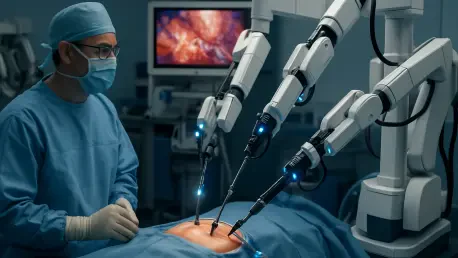Imagine a future where the vast majority of surgeries in the UK are performed with the precision of robotic systems, dramatically cutting down recovery times and improving patient outcomes across the board. The National Health Service (NHS) has embarked on an ambitious journey to transform the landscape of surgical care by integrating advanced robotic technology into 90% of minimally invasive procedures by 2035. Currently, only about 20% of such surgeries—equating to roughly 70,000 annually—utilize these cutting-edge systems. The goal is to scale this number to an impressive 500,000 surgeries each year, a leap that promises to alleviate patient wait times and optimize hospital resources for critical operations like joint replacements. This bold initiative draws inspiration from global leaders like the US, where robotic surgeries already number over 2.6 million annually, highlighting a path the UK aspires to follow. As this technological revolution unfolds, the potential to redefine healthcare delivery becomes increasingly tangible, setting the stage for a deeper exploration of its implications.
Driving Precision and Efficiency in Healthcare
The push for robotic surgery in the UK is rooted in the unparalleled benefits these systems offer over traditional methods. With enhanced precision and stability, robotic tools surpass the limitations of human hands, enabling surgeons to perform complex procedures through smaller incisions. Equipped with advanced 3D cameras and steady instruments, these systems minimize tissue damage, which translates to faster recovery periods and reduced risk of complications for patients. For the NHS, this means the possibility of freeing up hospital beds more quickly, allowing for a higher turnover of critical surgeries. The vision of scaling robotic interventions to 500,000 annually by 2035 underscores a commitment to not just keeping pace with global advancements but setting a new standard for patient care. As these technologies become more integrated, the potential for improved outcomes in procedures such as hysterectomies becomes a compelling driver for widespread adoption across the healthcare system.
Beyond the immediate benefits to patients, the efficiency gains for healthcare providers are substantial. Robotic systems streamline surgical workflows by reducing the time spent in operating rooms and lowering the likelihood of follow-up procedures due to complications. This efficiency is particularly vital in a system like the NHS, where resources are often stretched thin. The ability to perform more surgeries in less time could significantly address backlogs, a persistent challenge in the UK’s healthcare landscape. Moreover, the data generated from digitized operating environments offers real-time insights, helping surgeons make informed decisions during procedures. While the current adoption rate stands at a modest 20%, the trajectory toward a tenfold increase over the next decade signals a transformative shift. This evolution is not merely about adopting new tools but about fundamentally reshaping how surgical care is delivered to meet the demands of an aging population and increasingly complex medical needs.
Navigating the Challenges of Adoption
Despite the clear advantages, the road to widespread robotic surgery in the UK is fraught with significant hurdles, particularly around cost. The price tag for robotic systems ranges from $500,000 to $2.5 million per unit, with annual maintenance costs hovering around $100,000. This financial burden translates to higher procedure costs—robot-assisted abdominal surgeries, for instance, average $18,300 compared to $16,000 for traditional laparoscopic methods. Additionally, the limited lifespan of robotic tools, often needing replacement after just 15 to 20 uses, contrasts sharply with the durability of conventional instruments that can last over a decade. For the NHS, balancing these expenses against budget constraints poses a formidable challenge. While the long-term benefits of reduced recovery times and fewer complications are evident, the upfront investment required to equip hospitals with these technologies remains a critical barrier to achieving the 2035 target.
Another obstacle lies in the resistance from medical professionals accustomed to traditional techniques. Many surgeons argue that laparoscopic methods yield comparable outcomes to robotic alternatives, questioning the necessity of such a costly transition. The learning curve associated with mastering robotic systems further complicates adoption, as it demands significant time and training resources. Overcoming this skepticism will require not only demonstrating the superior precision of robotics but also ensuring accessible training programs to build confidence among practitioners. The disparity in adoption rates—20% in the UK versus a much higher rate in the US—highlights the cultural and systemic differences that must be addressed. As the NHS works toward its ambitious goal, fostering a mindset shift within the surgical community will be as crucial as securing the necessary funding to procure and maintain these advanced systems over the coming years.
Envisioning a Digital Surgical Future
The potential of robotic surgery extends far beyond current applications, paving the way for groundbreaking innovations in healthcare delivery. Experts in the field, such as David Fischel of Stereotaxis, emphasize that robotics serves as a foundation for future advancements like remote collaboration among physicians. Imagine surgeons consulting in real-time across continents, leveraging robotic systems to guide procedures from afar. The integration of artificial intelligence (AI) further amplifies this potential, with digitized operating rooms capable of storing data and providing actionable insights during surgeries. These technologies can alert surgeons to potential risks and suggest optimal next steps, enhancing both safety and efficiency. As the UK aims to transform its surgical landscape by 2035, embracing these digital tools could position the NHS at the forefront of global healthcare innovation, redefining what is possible in patient care.
Looking ahead, the synergy between robotics, AI, and remote connectivity promises to reshape surgical practices fundamentally. The trend toward a digital surgery revolution suggests that accessibility and integration into standard care will improve over time, making these technologies more viable for widespread use. For the NHS, this means not only achieving the target of 90% robotic minimally invasive surgeries but also setting a precedent for how technology can address systemic healthcare challenges. The journey from 70,000 to 500,000 annual robotic surgeries is ambitious, yet the groundwork being laid today points to a future where precision and innovation are the norm. As systems become more cost-effective and training becomes more accessible, the barriers to adoption may gradually diminish. This vision of a digitally enhanced surgical ecosystem offers a glimpse into a transformative era where patient outcomes and operational efficiency reach unprecedented heights.
Reflecting on a Bold Technological Leap
Looking back, the strides made in envisioning a robotic-driven surgical landscape in the UK stand as a testament to bold ambition. The commitment to scaling robotic interventions from a mere 20% to 90% of minimally invasive procedures by 2035 is a defining moment in healthcare planning. Challenges like high costs and professional resistance are acknowledged as significant, yet the promise of enhanced precision and faster recoveries fuels the drive forward. As discussions progress, the focus shifts toward actionable strategies—securing funding, expanding training, and integrating AI to support surgical teams. The next steps involve fostering partnerships between technology developers and healthcare providers to ensure affordability and accessibility. Ultimately, the legacy of this initiative rests on its ability to inspire a future where digital tools not only support but redefine surgical care, offering a model for global healthcare systems to emulate in the years that follow.









